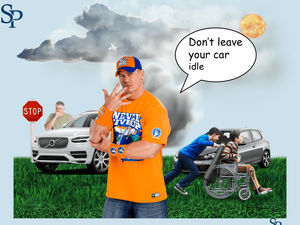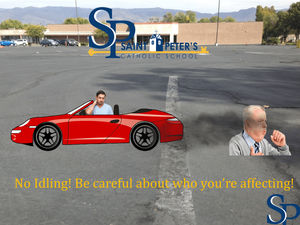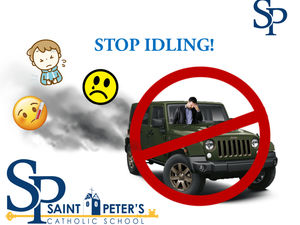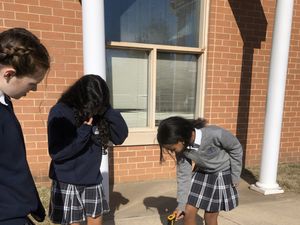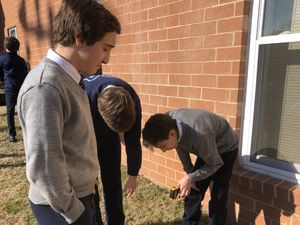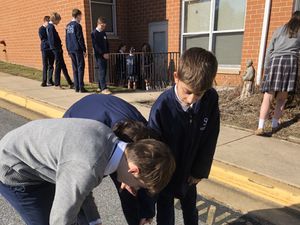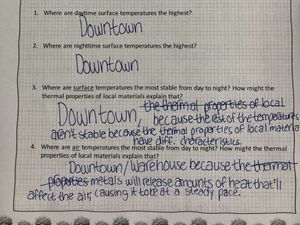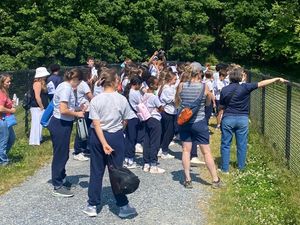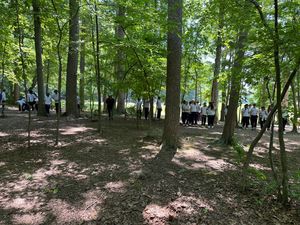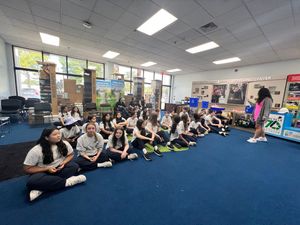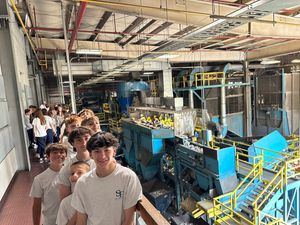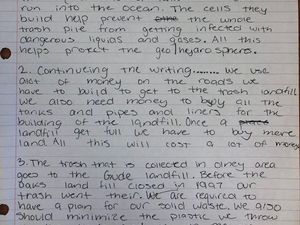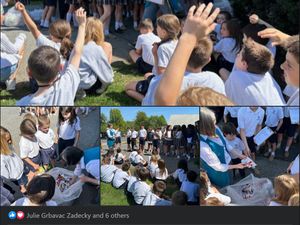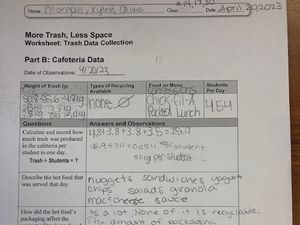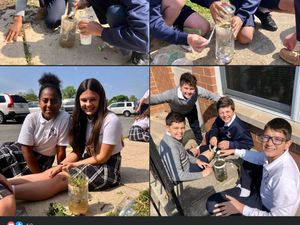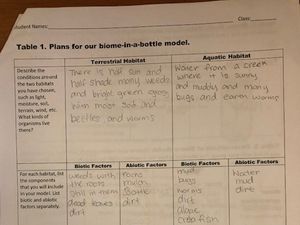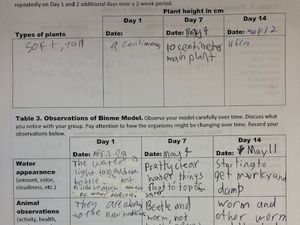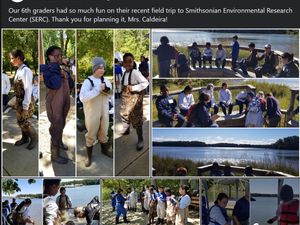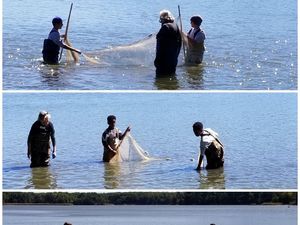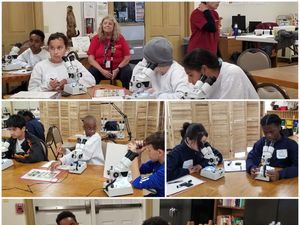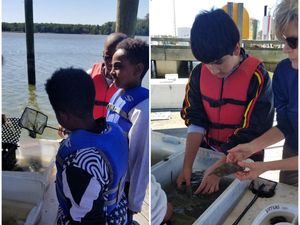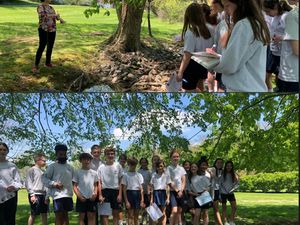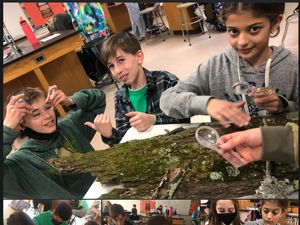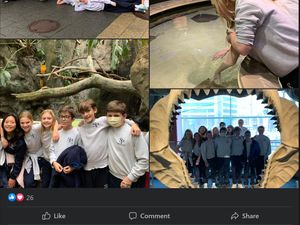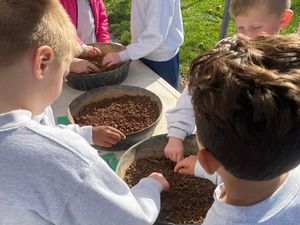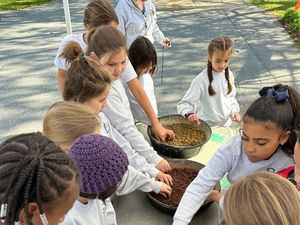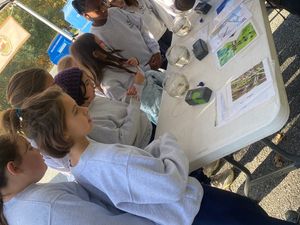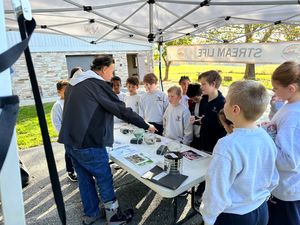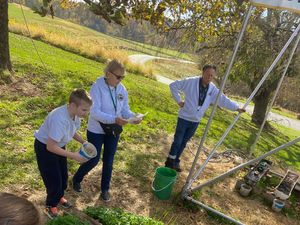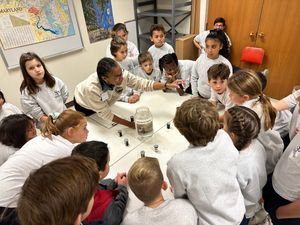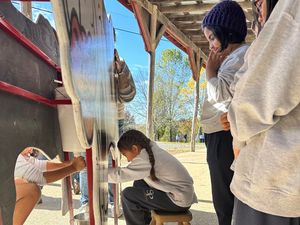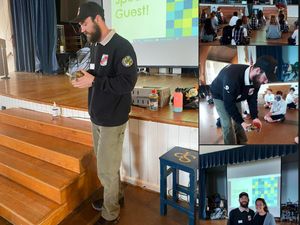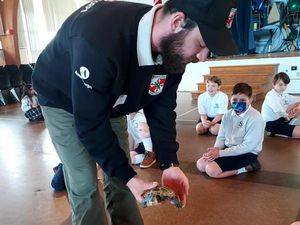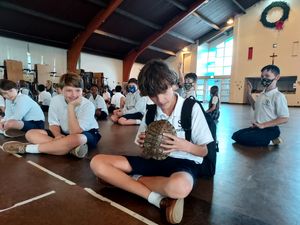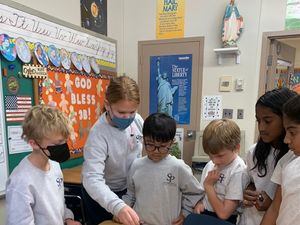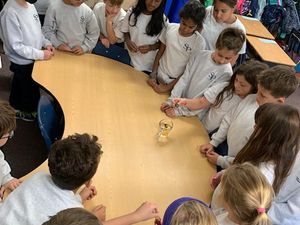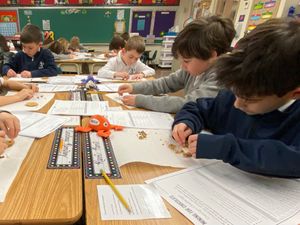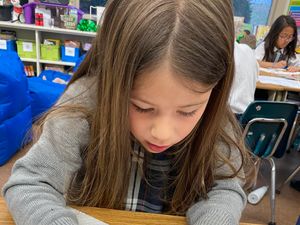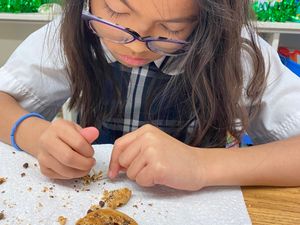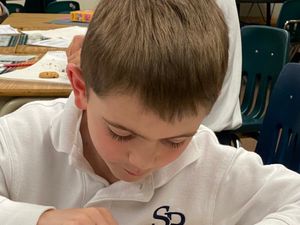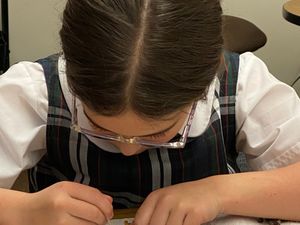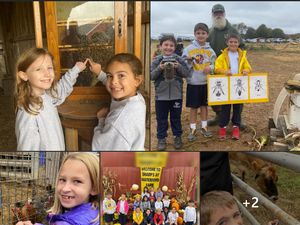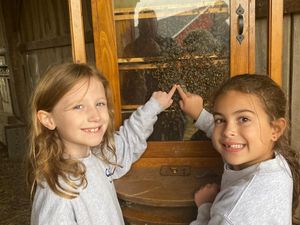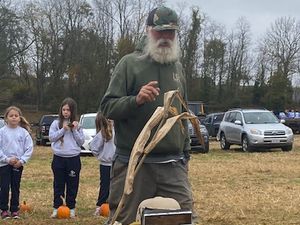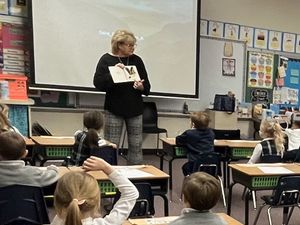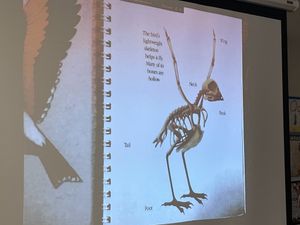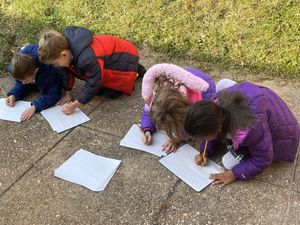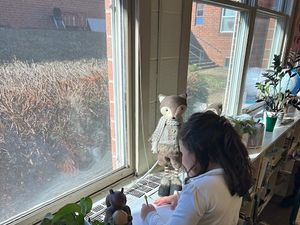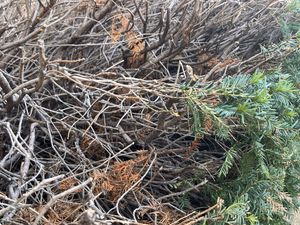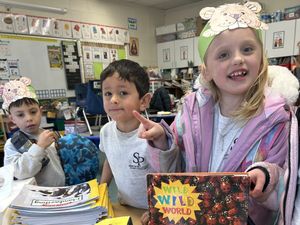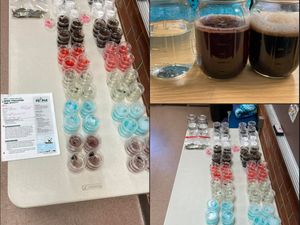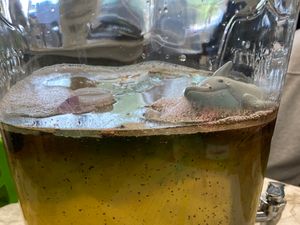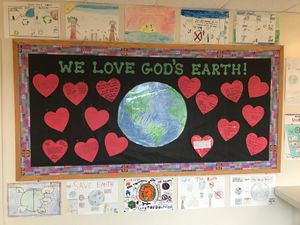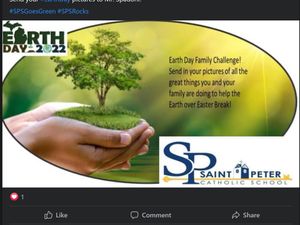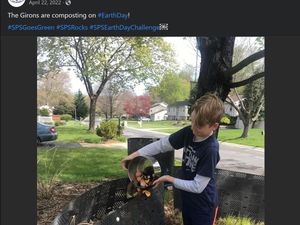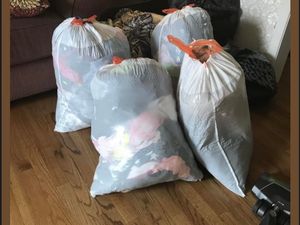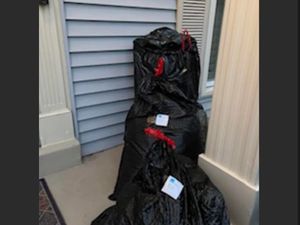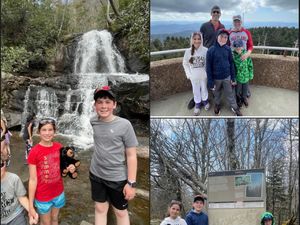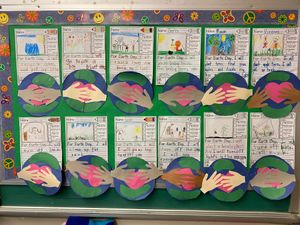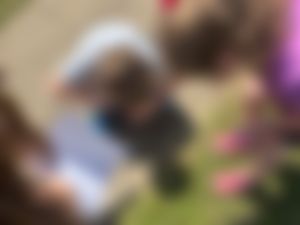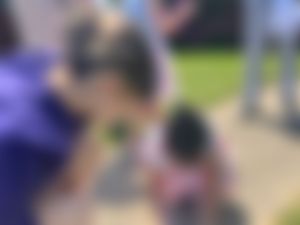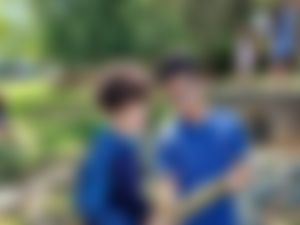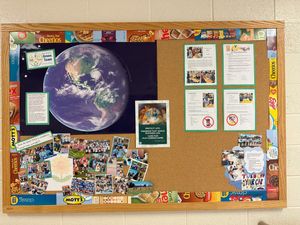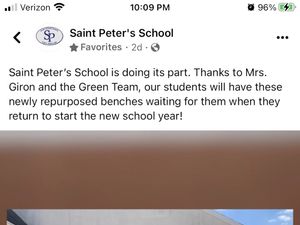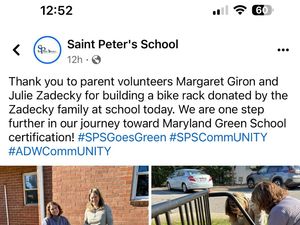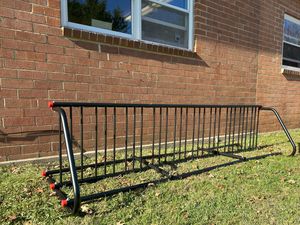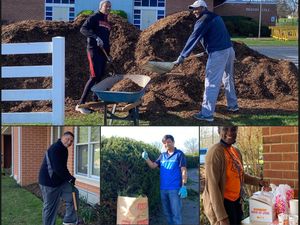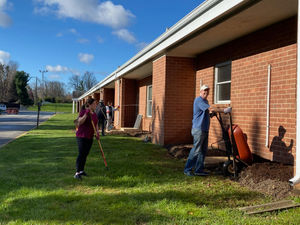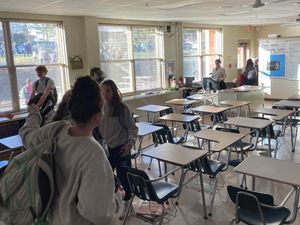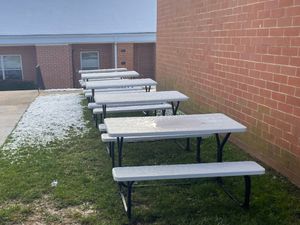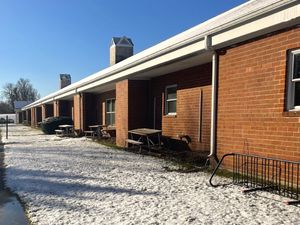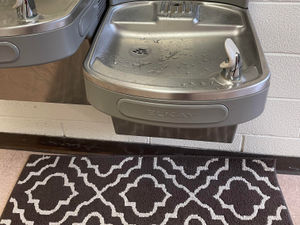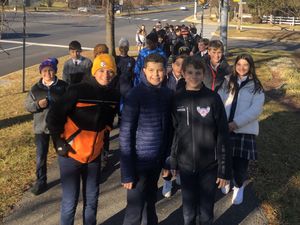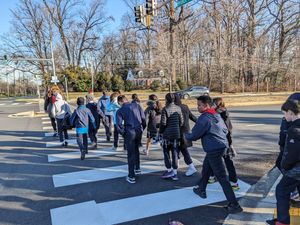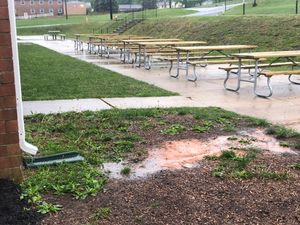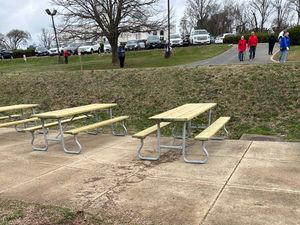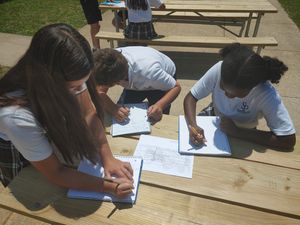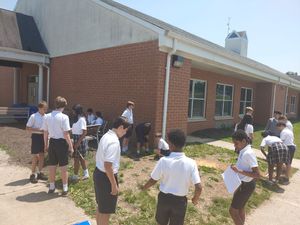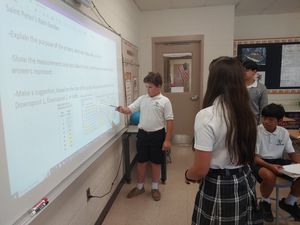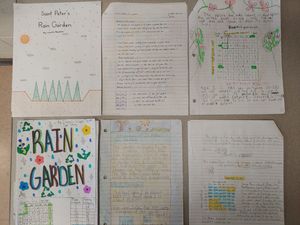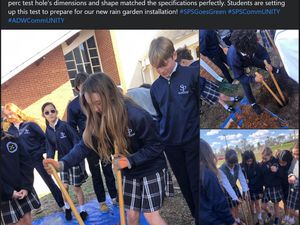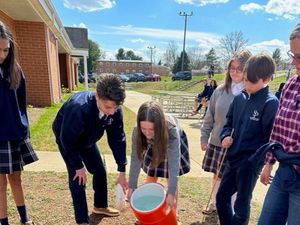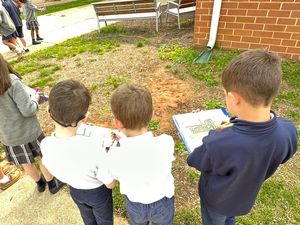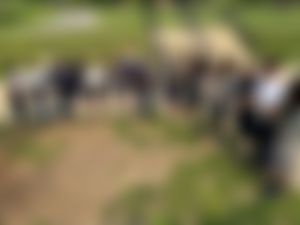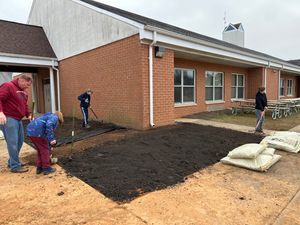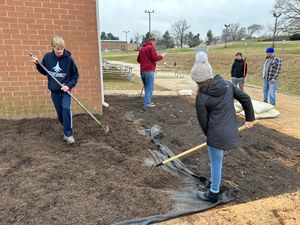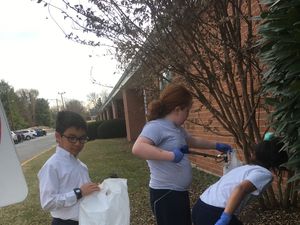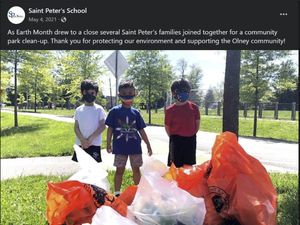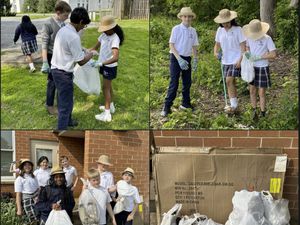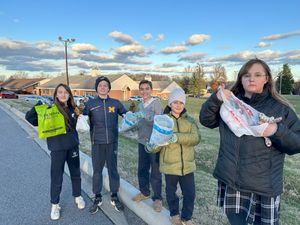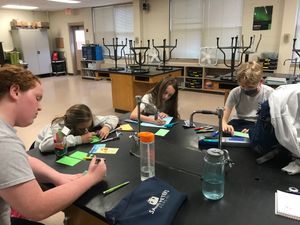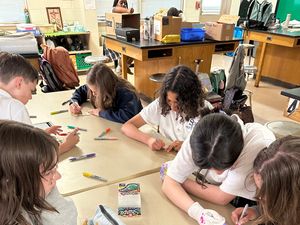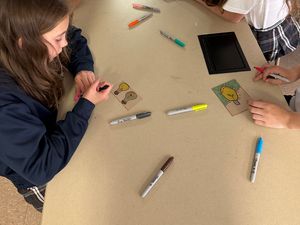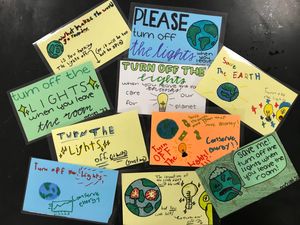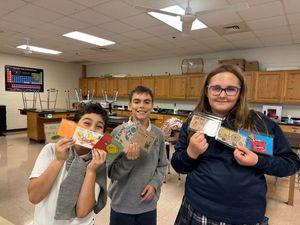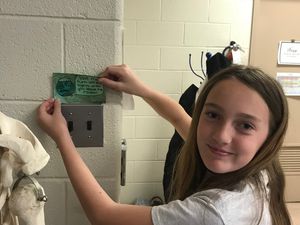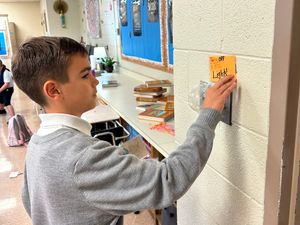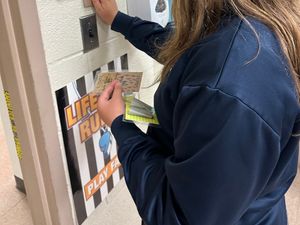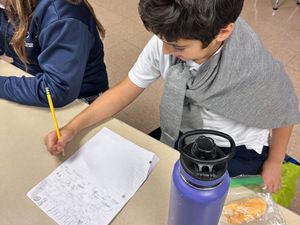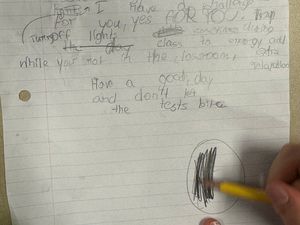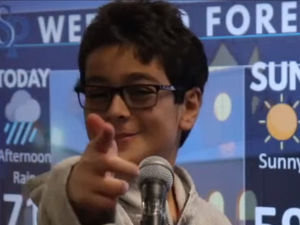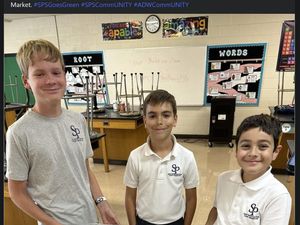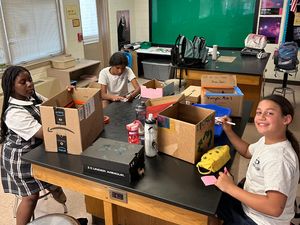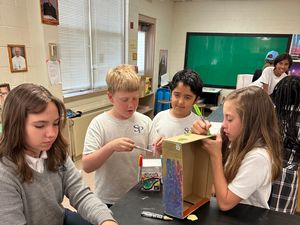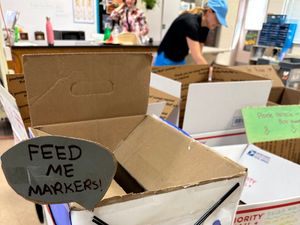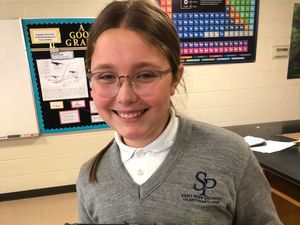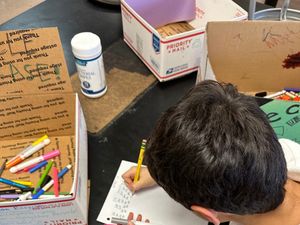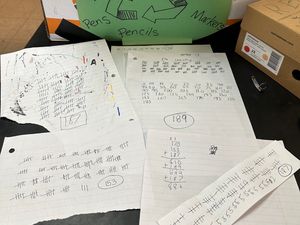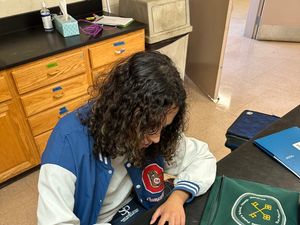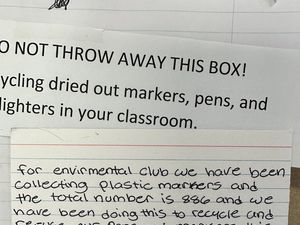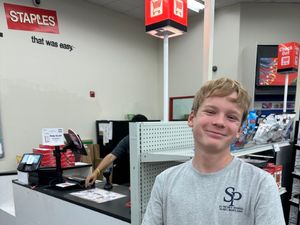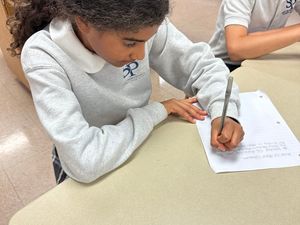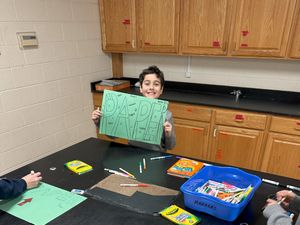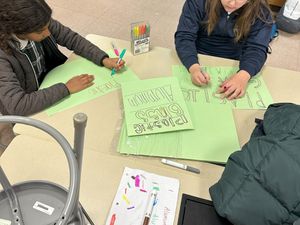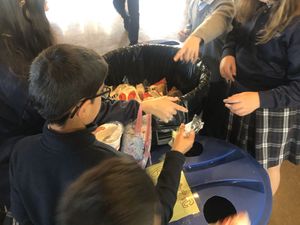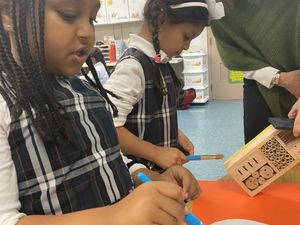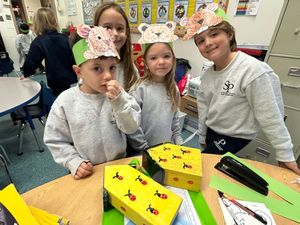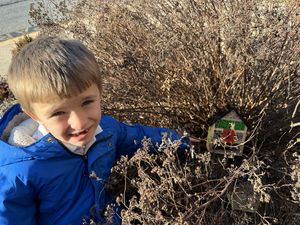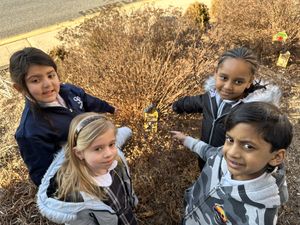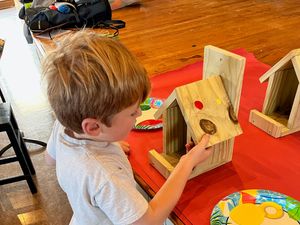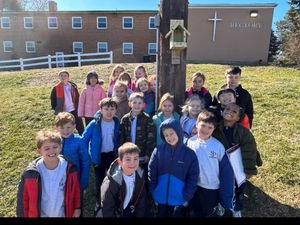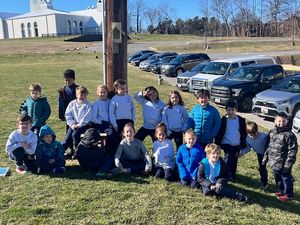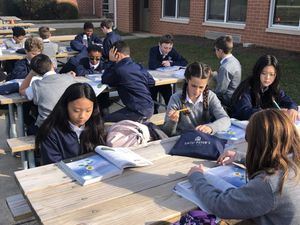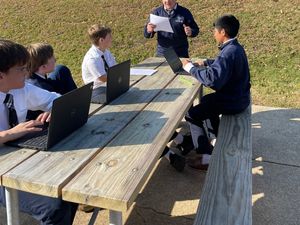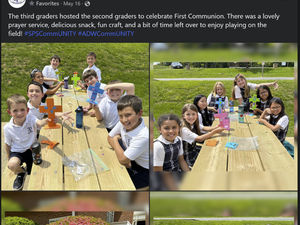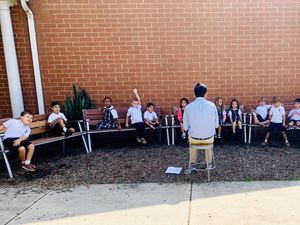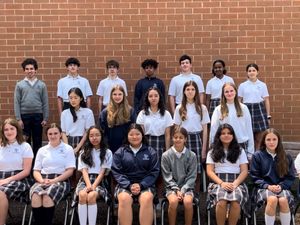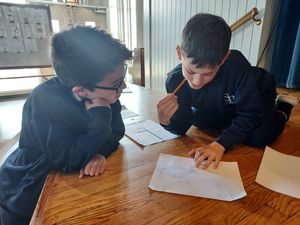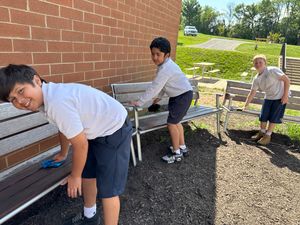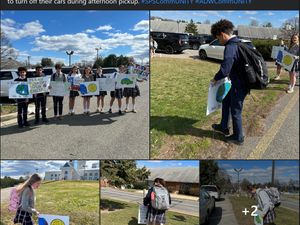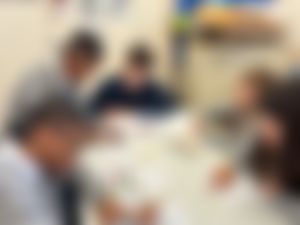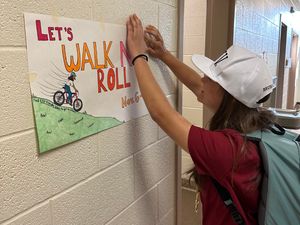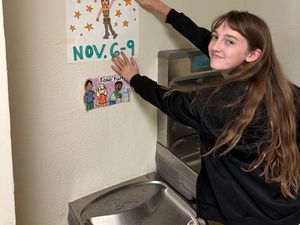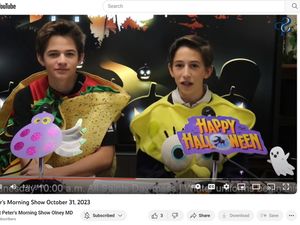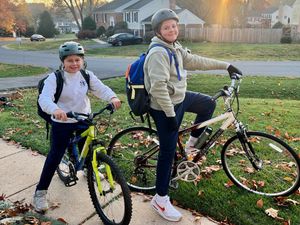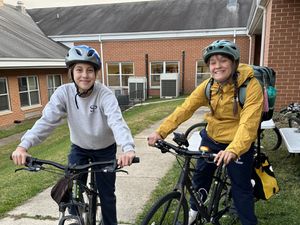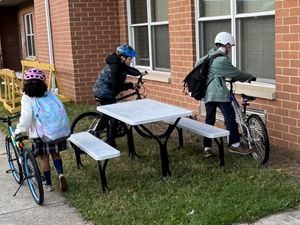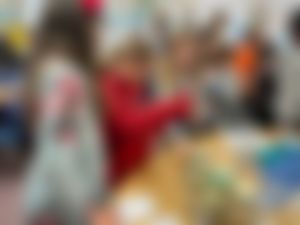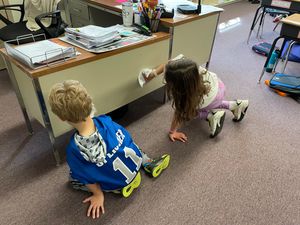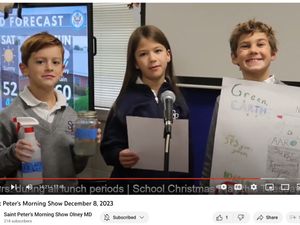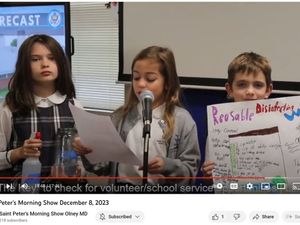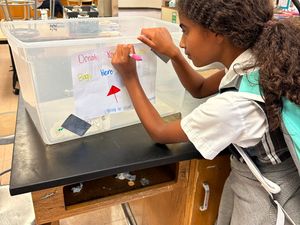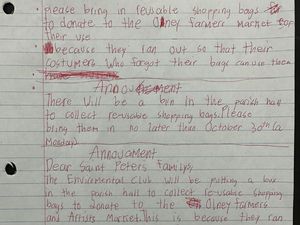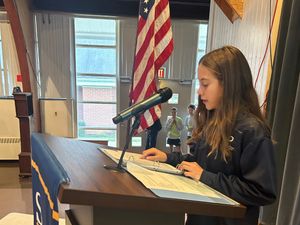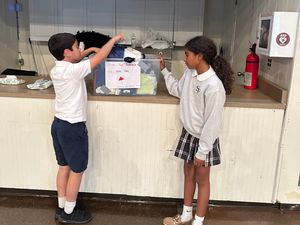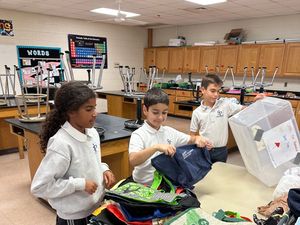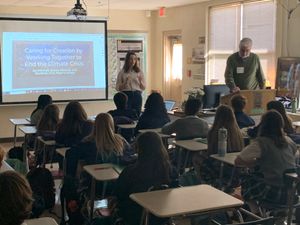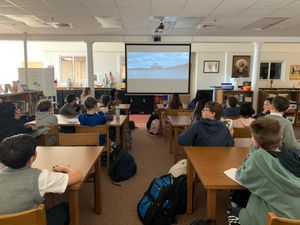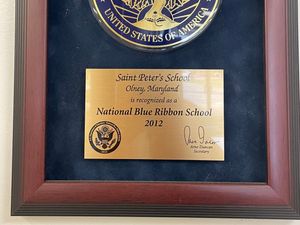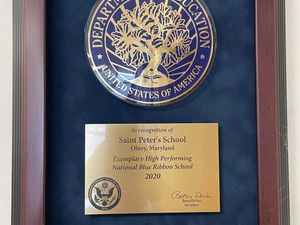Systemic Sustainability
Environmental Curriculum and Instruction
1.1 Curriculum and Instruction
Elementary & middle schools must provide one example of outdoor/environmental instruction per grade level.
High schools must provide one example of outdoor/environmental instruction in four subjects (which may include multiple different differents sciences).
In computer class, 7th and 8th grade students were asked to create graphic art posters, using Microsoft Publisher, depicting the harmful effects of idling your car. These were intended to serve as reminders to parents to please shut off their cars during dismissal. Realizing we do not have adequate photo documentation of the students actually working on the computers, we're including a sample of some of the final products, mainly for laughs : )
Students applied concepts from the EPA Fact Sheet "Keeping Your Cool" to make predictions about the possible urban heat impacts of the surface materials surrounding our school building. Students used infrared thermometers to measure surface temperatures of, as well as the air temperature above, surfaces such as grass, concrete, asphalt, and mulch in both sunny and shady areas. They then analyzed satellite data documenting local urban heat impacts, including our school. Students integrated their observations and analyses to compose a list of actionable recommendations for reducing the urban heat impacts on our school campus.
8th grade students using infrared thermometers to measure the temperature of the concrete sidewalk outside the school.
8th grade students using infrared thermometers to measure the temperature of a grassy surface.
8th grade students using infrared thermometers to measure the temperature of asphalt outside the school.
Student worksheet, page 1.
Student worksheet, page 2.
Students experienced a guided tour and class at the local recycling center to enrich their understanding of the solid waste streams in our community. They gained knowledge about how to recycle properly and seek out recycled products. They then visited Lake Needwood park featuring a man-made lake with an earthen dam. Students discussed the risks and benefits of the dam to the community and the natural environment. After eating lunch at the park, the students performed a police-line style trash clean-up. Finally, students visited a closed landfill to observe the mechanisms in place for capturing methane, treating leachate, and monitoring the soil and groundwater for possible contamination.
Students standing on the earth dam looking toward Lake Needwood while Mrs. Caldeira spoke about the effects of the dam on the local community.
After eating lunch at the park, the students formed a police line and performed a trash clean-up of ALL trash; not just their lunch trash.
Students engaged in class discussion at the Montgomery County transfer station in Gaithersburg.
Students toured the sorting facility at the transfer center.
Students studied the design elements of a landfill that prevent contaminating the surrounding land and groundwater. They researched local laws and ordinances governing landfill operations and summarized their findings in an information report.
Students worked in groups to measure and inspect the trash collected in a 24-hour period from two classrooms and the cafeteria. Students discussed their observations and speculated about how the school could reduce its solid waste burden for the landfill, such as by increasing recycling collections and discouraging single-use packaging.
Students worked in small groups to plan and construct a terrarium-like model depicting the cycling of matter (i.e., carbon, oxygen, nitrogen, and water cycles) in Earth's natural systems. They gathered biotic and abiotic elements from a variety of local habitats of their choosing. Students then observed the ecosystem interactions in their model over a span of two weeks and analyzed evidence of a self-sustaining food web. Later they examined the microorganisms from their model under microscopy.
Students engaged in four different hands-on activities to deepen their understanding on Chesapeake Bay ecosystems and human impacts on those ecosystems. (1) Students experienced a guided nature walk through a wetland habitat and searched for scat and other evidence of animal activity. (2) Students examined the variety of invertebrates collected in crab pots and sorted them into tanks according to their characteristics. (3) Student observed living plankton specimens under microscopy and discussed their roles in the broader ecosystem. (4) Students donned wading gear and practiced seining as a research strategy to document biodiversity.
Social media post with photos of students at SERC actively learning.
Students at SERC wearing waders and practicing seine fishing.
Students at SERC observing living plankton specimens.
Students at SERC examining and sorting invertebrates.
SERC field trip Email (1.75 MB)
Email planning the field trip.
6th graders learned how stormwater flows through our watershed around St. Peter’s and beyond. Stormwater from our school collects into a small creek on school grounds. Students examined the variety of life supported in the creek habitat, including frogs, insects, and other creatures. Students studied satellite imagery to understand the path of water from the creek into local waterways and eventually the Chesapeake Bay. Students discussed the potential sources of runoff pollution in our local neighborhood and roadways.
In conjunction with their class discussion on how lichens are key producers in tundra biomes, students had the opportunity to examine lichen samples up close.
The fifth grade students visited the National Aquarium after learning and exploring the life cycles of animals. During a hands-on experience with jelly fish, they learned about the different types of jelly fish and how they lived. Students completed a scavenger hunt throughout the field trip to gain knowledge of all the different types of animals in different ecosystems.
4th & 5th Graders visited the Agricultural History Farm Park for the “Close Encounters with Agriculture” program. The students walked to different stations while learning about the environment, nutrition / diet / health, and the production of Agriculture. Refer to the attached PDF for a full description of activities.
Students learning about different types of soil.
Students learning about different types of soil.
Students learning about stream life and how each stream 'creature' is important for the growth of other natural resources.
Students learning about stream life and how each stream 'creature' is important for the growth of other natural resources.
Students watched how plants can clean water run-off from rain.
Students watched how plants can clean water run-off from rain.
While listening to a story about water pollution, students 'polluted' the Potomac River (jug of water) with the items in the black canisters every time specific words were read.
Students 'milking' a 'cow', and learning about how milk and cheese are made.
Students 'milking' a 'cow', and learning about how milk and cheese are made.
Students learned about the different types of grains and how each one is essential to good nutrition.
Agricultural History Farm Park Field Trip Summary (1.01 MB)
Learning Stations summary.
During an in-school presentation by a team member from the Maryland Conservation Core, the 4th graders learned about the Chesapeake Bay, the problems affecting it, and the importance of protecting it for our safety, health, economy, and as an important resource for our future. They also got a chance to meet a rescued terrapin from the Bay.
3rd graders examined the different pollutants that we produce daily that affect our air quality. For each pollutant, a drop of food coloring was added to water to visually demonstrate its effect on the air we breathe. Pollutants included car rides to school, household cleaners or paints, pollutants from lawn mowers or bug sprays/insecticides, and machine use like stoves. They were able to see how quickly our air is polluted, and how the combined effect was so obvious in the discoloration of the water. Questions discussed: What if air pollution was always this easy to see, would we want to breathe this air? How could we lessen the effects of the many pollutants we generate?
2nd Graders raised Painted Lady butterflies in their classroom, and taught the PreK students about pollinators, specifically the butterfly’s life cycle and migration patterns. PreK visited their classroom multiple times as all students monitored the captive butterflies as their metamorphic stages progressed. When the butterflies were mature, the students released them outside.
Students were challenged to "mine" the most chocolate chips "minerals" out of their cookie "Earth's surface" by using toothpicks while causing the least amount of damage to the cookie. In addition to the activity, the class discussed how their mining affected the condition of the cookie, related this to how real mining may affect the ecological systems in and around the disturbed area, and the cost of environmental repair.
Example worksheet that students filled out. Unfortunately, we do not have a copy of one that was filled out.
Photo of students 'mining' for chocolate.
Photo of student 'mining' for chocolate.
Photo of student 'mining' for chocolate.
Photo of student 'mining' for chocolate.
Photo of student 'mining' for chocolate.
During our field trip to Sharp’s at Waterford Farm, second graders learned how important bees are and how they help Farmer Chuck with his crops. They participated in a bee keeping class, and listened to various guides speak about natural resources, human resources, and conservation.
First grade students researched birds to learn more about their habitats. After reading a book about them, they observed and sketched some birds trying to nest in the bushes outside their classroom. During their observations, the students noticed that these bushes were dying. Concerned that the bushes may be removed because they were sick and the birds might lose their home. Refer to Objective 2 Habitat Restoration section to see what the students chose to do to create a safe home for the birds.
Kindergarten students read and discussed books about ladybugs and bees to learn more about their habitats and how important these insects are to plants and humans. Refer to Objective 2 Habitat Restoration section to see what the students did to create a safe home for these insects!
(This is an extra as we realize we do not have students shown in our supporting documentation, but it is a cool activity that occurs annually in 4th Grade) In this activity, students participated in an interactive story about the changes humans have made to a river over time and learned how many of our rivers have become polluted. This example demonstrates that just as we each contribute to the problem, we can also be part of the solution. Students: Discussed ways people pollute a water source; Proposed methods for preventing and cleaning up water pollution; Explained why it is more effective to prevent pollution than to clean it up after the fact.
1.2 Green School Awareness
1.2.1 School Wide Awareness - Staff
Demonstrate that all school personnel are aware of your school's Green School status and application process.
Faculty members of the Green Team have made multiple announcements over the last 3 years during all-staff meetings so that all teachers are aware of the certification program, guidelines, application process, etc.
Joe Tremblay presented an introduction to the Green Schools program, and explained the application process per his email summary provided below.
Part 1- Kelly Nichols sent a staff-wide email with a pdf of the application guidelines with comments marked up by the Green Team Chair. We did this so that we wouldn't have to print out 40+ copies of the application guidelines. Copy provided below.
Part 2- Kelly then presented an outline version of the application process during an all-staff meeting. Copy provided below.
Signature sheet indicating that teachers read the email and attended the staff meeting is provided below.
Page 1 of signature sheet indicating all faculty have read the email & attachment, and were present at the all-staff meeting.
Page 2 of signature sheet indicating all faculty have read the email & attachment, and were present at the all-staff meeting.
Page 3 of signature sheet indicating all faculty have read the email & attachment, and were present at the all-staff meeting.
Announcement 2- Key Points for Teachers and Staff (228.98 KB)
Summary of full-staff meeting announcement.
MD Green Schools Application Information packet_October 2023 (1.03 MB)
Marked up copy of application guidelines that was emailed to teachers.
1.2.2 School-Wide Celebration
Demonstrate how your school celebrates beig a Green School by hosting a school-wide environmentally-focused event open to all students.
Each year, Saint Peter's School celebrates Earth Day in some way. Usually with an outdoor buddy activity. This school year's celebration will occur again on Earth Day, after the submission of our application.
In 2022, we held an additional school-wide celebration by asking the students to watch some education videos and then write "love letters" to the Earth.
All students (roughly 450) watched two 5-minute videos on recycling and Laudato Si'. After the videos, each class discussed answers to the questions: Why do we love God's Earth? What will we do to protect it? and Why do we need to? Each class then prepared a written response on a paper Valentine heart, and all hearts were displayed on a bulletin board near the school lobby.
Collage of Hearts (259.54 KB)
Collage of the love letters written by each classroom.
Valentines Letters to the Earth - middle school request (195.29 KB)
Request and description of activity for middle school students.
Valentines Letters to the Earth - primary_intermediate request (177.13 KB)
Request and description of activity for elementary school students.
Earth Day 2022 occurred over Easter break, so the school promoted an Earth Day Family Challenge where families shared photos, on social media, of their "green" activities over Break. Some of the lower grades also celebrated Earth Day ahead of time by creating posters of what they plan to do to help the Earth.
Social media post announcing Challenge to families (this was also posted in the schoolwide email).
Composting over break!
Preparing clothes for donation and reuse over break.
Preparing clothes for donation and reuse over break.
Hiking for improved mental and physical health over break!
Students with their posters of how they intend to help God's Earth.
Student posters displayed on their class bulletin board.
All students participated in a scavenger hunt buddy activity (where older students are paired with younger grades). Students searched around the school grounds for items in nature whose name begins with each letter of the alphabet.
The second graders also spent time outside shadow tracing.
Students looking for items on scavenger hunt list.
Students with their buddies looking for items on scavenger hunt list.
Students filling out their list.
Students and their buddies looking for items on scavenger hunt list.
Students filling out items on scavenger hunt list.
Students tracing shadows and spending time outdoors.
Students tracing shadows and spending time outdoors.
Student tracing shadows and spending time outdoors.
1- Earth Day 2023 Alphabet Scavenger Hunt Buddy Activity (948.12 KB)
Scavenger hunt worksheet.
The Green Team maintains a bulletin board in the middle school hallway for the purpose of displaying student project photos and green information.
We also have a new website dedicated to Green announcements and photos of the student green projects: https://stpetershsb.membershiptoolkit.com/story/392295
The Green Team bulletin board utilizes the original cork background (no wasted paper) and repurposed cereal boxes as its border. Student projects and other green information is posted here.
Green Team Website- Laudato Si (720.98 KB)
PDF of the Green Team website explaining what Laudato Si' is.
Green Team Website- Main Page (1.78 MB)
PDF of the Green Team website Main Page.
Green Team Website- Student Projects (430.78 KB)
PDF of the Green Team Student Projects website.
Environmental Professional Development for Teachers
1.3.1 Environmental Professional Development for Teachers
Demonstrate that 10% of staff have completed an environmental PD. Instructional staff is defined as any staff that manages a gradebook.
- New Schools must have all PD completed within the past 2 academic years.
- Renewing schools must have all PD completed within the past 4 academic years.
A teacher who has participated in multiple workshops may only be counted once..
Three of our classroom teachers attended a webinar by Nature Forward (fka The Audubon Naturalist Society) entitled "Simple Strategies for the Green Classroom: Energy Conservation and Creating a Healthy School Environment."
One teacher is in the process of completing NOAA's MWEE 101 course.
During the webinar "Simple Strategies for the Green Classroom", by Nature Forward, attendees learned how to implement energy conservation projects in the classroom, and how to create a healthier school environment. They broke into small groups and discussed specific ideas for how to implement each of these topics.
Bieberich-Lozupone-Pak Certificate (893.94 KB)
Certificate of completion for the webinar.
During the webinar "Simple Strategies for the Green Classroom", by Nature Forward, attendees learned how to implement energy conservation projects in the classroom, and how to create a healthier school environment. They broke into small groups and discussed specific ideas for each of these topics.
Bieberich-Lozupone-Pak Certificate (893.94 KB)
Certificate of completion for the webinar.
During the webinar "Simple Strategies for the Green Classroom", by Nature Forward, attendees learned how to implement energy conservation projects in the classroom, and how to create a healthier school environment. They broke into small groups and discussed specific ideas for each of these topics.
Bieberich-Lozupone-Pak Certificate (893.94 KB)
Certificate of completion for the webinar.
1.4 Achieving Sustainable Schools
1.4.1 School-Wide Staff Sustainability
Demonstrate the sustainability practices your teachers, staff, and other personnel have implemented school-wide to make your school green. Any actions involving students belong under Objective 2.
Adults have: reduced paper use by printing double sided, using coffee mugs, sending electronic communications and using digital file storage for school board agendas/minutes. We host 2 Used Uniform Sales and 3 cleanup days per year; have installed water bottle filling stations, a bike rack, picnic tables outside every classroom, an outdoor seating area with repurposed benches. Roughly 1/3 of our classrooms have live plants, our MS Literature teacher uses only natural light during class, and students walk to the Olney Theatre annually. The Green Team has provided Eco fun facts in school emails and on social media, and created a website for announcements and project progress photos.
Benches were refurbished and donated to the school to create an outdoor seating space for students.
Social Media post celebrating new bike rack.
New bike rack able to accommodate up to 20 bikes.
3 times per year, adult volunteers clean up the school grounds (weeding, mulching, picking up trash, etc) and sanitize the inside of the school.
Mulching during clean-up day.
All middle school students have the opportunity every day to have class using natural light in Ms. McGowan's Literature class.
Picnic tables have been provided outside every classroom so that each class can eat lunch (and do other things) outside.
Picnic tables along the elementary school wing.
Saint Peter's has two water bottle filling stations; one in the middle school wing and one in the elementary school wing. Students are encouraged to use their reusable water bottles instead of single-use disposable bottles.
Water bottle filling station in the elementary school.
Students in all grades walk from St. Peter's to the Olney Theater Centre at least once a year to watch one of the productions.
Students in all grades walk from St. Peter's to the Olney Theater Centre at least once a year to watch one of the productions.
02- A New Gathering Place - Saint Peter_s School Olney (358.76 KB)
Article announcing new benches.
03- Bike Rack Proposal (196.24 KB)
Proposal written by parent green team members requesting bike racks for the students.
06- Classroom Plants Collage (298.52 KB)
Examples of live plants in roughly 1/3 of our classrooms.
09- Electronic Communications Examples (1.15 MB)
Examples of the many ways Saint Peter's faculty eliminates the use of paper by utilizing electronic communications and forms.
13- Waste Reduction Practices (195.51 KB)
Examples of additional waste-reduction practices by faculty.
16- Middle-School Supply List- NO Disposable Water bottles (429.04 KB)
The Middle school student supply list includes a reusable water bottle instead of cases of disposable water bottles.
1.4.2 Systemic Partnership
Demonstrate one partnership with a central office or board within the school system that supports part of the Maryland Green Schools Program. Any partnerships outside of your school system belong under Objective 3.
The Green Leaders at St. Peter's School wrote a letter to Kelly Branaman, the ADW Secretary of Catholic Schools and Superintendent of Schools, explaining our intent to apply for MAEOE Green Schools certification, and to confirm her approval and support. She responded with emphatic approval and support. Copies of our letter and her response are provided.
2023-4-17_Saint Peters Green Initiative Letter to Ms Branaman (225.7 KB)
Saint Peter's Green Team letter to Ms. Branaman.
Email to Kelly Branaman (75.51 KB)
Email delivering the letter to Ms. Branaman.
Kelly Branaman Response (96.1 KB)
Ms. Branaman's response providing approval and support of our green initiative.
Student Action
Schools must document eight total actions that address at least three of the listed sustainability practices.
These are student actions not adult actions. Adult sustainable actions can be documented in Objective 1.4.
2.1 Water Conservation/Pollution Prevention
2.1 Water Conservation/Pollution Prevention
Students designed a rain garden to collect roof downspout water to prevent it from washing into a nearby storm drain. Math classes calculated the runoff collected by the downspout and determined the required rain garden size. 7th grade Science classes performed a PERC test and determined that the clayey soil in that area did not drain very well and needed to be replaced with topsoil. 2nd grade students helped by monitoring the sun/shadows to determine what kinds of plants would thrive best in that area, and the Environmental Club researched and selected the native plants and shrubs that will be used. The garden has been excavated, backfilled, and mulched, and students will plant this spring.
Downspout causing mulch to wash across sidewalk into adjacent storm drain.
Trail of mulch across sidewalk to storm drain.
Middle school Math students calculating the amount of roof run-off using dimensioned roof plans.
Middle school Math students measuring the available space in the proposed rain garden location to ensure it is large enough for the required footprint.
Middle school Math students calculating the required rain garden size using the information published in Montgomery County's Rain Scapes program design guide.
Student projects summarizing their calculations.
7th grade Science classes digging the hole for PERC test.
Filling the hole with water.
2nd graders monitored how the sun moves through the garden space and drew sketches of the shade locations at various times of the day.
2nd graders with their clipboards and shadow sketches.
Environmental Club students discussing plant size, quantity and general layout.
Environmental Club students researching native plants online to select which species they want to plant.
Heavy equipment was used to excavate the clayey soils out of the rain garden footprint. Students and adults participated in this activity.
Students and adults helped to backfill the rain garden with topsoil.
Spreading mulch around the garden and adjacent seating area.
Student and adult landscape crew! Excavation complete; planting will occur with warmer weather this spring.
Students helped to place the benches back where they belong.
Rain Garden-7 (90.45 KB)
Students monitored the water level over several days, recorded their results and plotted a graph the drainage rate.
Rain Garden-10 (559.04 KB)
Student shadow sketches.
Rain Garden-13 (624.75 KB)
Student recommendations for plants and shrubs, and the final plants list.
Since its inception in 2016, the student Environmental Club has regularly picked up trash around the school and church campus, as well as the surrounding community.
School campus clean-up in 2018.
School campus clean-up in 2020.
Families participated in the clean-up of a local park.
School and church campus clean-up in 2022.
Cleaning up the soccer field.
School and church campus clean-up in 2023.
Cleaning trash out of Butterfly Park on Spartan Road in Olney.
School campus clean-up in the fall of 2023.
2.2 Energy Conservation
2.2 Energy Conservation
The Environmental Club members (roughly 25 different students) crafted signs with phrases and artwork encouraging students to turn off the classroom lights. The signs, largely made from upcycled cereal/chips boxes, were laminated, and the students posted them above the light switches in every classroom. Announcements were made on the school's Morning Show to explain to the students why it is important to turn off the lights, not only while the classrooms are empty, but also sometimes during class time for added savings and for relaxation. Links to video clip and full Morning Show are provided below.
Students creating signs during Environmental club meetings.
Students creating signs during Environmental club meetings.
Students creating signs during Environmental club meetings.
Samples of finished signs.
Samples of finished signs.
Samples of finished signs.
Students preparing signs to be hung with tape.
Student posting sign above classroom light switch.
Student posting sign above classroom light switch.
Student posting sign above classroom light switch.
Example of posted signage.
The students composed the announcement for the school's Morning Show.
Handwritten announcement that was then emailed to the Technology Lab teacher for placement in the teleprompter.
Environmental club student making an appearance on the Morning Show.
s!AntWXrZ_AaoXj1dWWGoXOfE_K_c9?e=up0PXm__20240223093143.html (0 B)
Link to video clip of morning show announcement.
watch?v=YVUyRkj0Pu8__20240223093287.html; charset=utf-8 (616.3 KB)
Link to full Morning Show (scroll to time 12:00min for announcement)
2.3 Solid Waste Reduction
2.3 Solid Waste Reduction
Grades Pre-K through 8 participated in collecting old unusable markers, highlighters, pens and plastic pencils during the end-of-year cleanout. We collected 886 items = 17 lbs! The Environmental Club decorated repurposed shipping/shoe boxes to use as collection boxes, which were distributed to each classroom. After several weeks, the club collected, sorted and counted the items before they were donated to Staples for recycling.
Social media post for the project.
Students making the collection boxes.
Students making & decorating the collection boxes.
Example of finished box.
Environmental Club student with her collection box.
Students sorting through the collected items to separate non-recyclables.
One of the environmental club students counting and tallying collected items.
All tally sheets.
Student composing the environmental club's announcement to the school with the results of the collection.
Written announcement to be given by an environmental club student during morning assembly.
Student at the podium giving the announcement to the entire school.
Dropping off the collected items at Staples!
Environmental Club announcement to teachers (677.35 KB)
Student-composed announcement to teachers about the marker recycling project.
School newsletter announcing marker collection (175.67 KB)
Announcement that went out to parents to send in their household's used markers, etc.
All students schoolwide recycle paper and comingled materials in their classroom recycling bins provided by the 2016 Environmental Club. Subsequent Environmental Clubs have monitored the recycling bins, ensuring that each classroom still has one of each, and that they are used correctly. The club students have provided feedback to the students on recycling 'mistakes' that they have observed. They also implemented and monitor the use of recycling bins in the school cafeteria during lunchtime.
Links to video clip of announcement and full Show on YouTube provided below.
Environmental Club students regularly check the school classrooms to see if the recycling bins are still there and whether they are being used properly.
Student composing announcement to the school about proper recycling bin use.
Student-written announcement.
Students made signs for the large recycling bins that they requested for the school cafeteria during lunchtime.
Students made signs for the large recycling bins that they requested for the school cafeteria during lunchtime.
While some Environmental Club students make announcements during lunchtime encouraging their classmates to use the recycling bins, others stand at the bins and monitor their use.
2- Recycling Bin Survey Results (942.19 KB)
Recycling bin (and classroom plants) survey results. Handwritten results from multiple students were compiled into a spreadsheet.
s!AntWXrZ_AaoXljOY19hW6z29KJRR?e=OvWdwE__20240223093446.html (0 B)
Link to video clip of announcement.
watch?v=yCbqsCLZmwU&t=637s__20240223093565.html; charset=utf-8 (602.68 KB)
Link to full morning show (scroll to time 9:10min for announcement).
2.4 Habitat Restoration
2.4 Habitat Restoration
After learning about bees, ladybugs, and other insects, the Kindergarten students wanted to give the insects a place to be safe. They painted bee houses and installed them outside in the butterfly garden so that the insects could have a safe home. Meanwhile, 1st grade students discovered some birds trying to nest in dying bushes outside their classroom and were concerned that the birds would lose their home if the sick bushes were removed. To provide a safe home for the birds, they decided to build some bird houses. With the help of their teachers, they learned about the important parts of a bird house, helped build and paint them, and installed them outside, away from the sick bushes.
Kindergarten students painting insect hotels.
Kindergarten students with their painted insect hotels.
Students in the butterfly garden ready to install their insect hotels.
Student placing insect hotel in a bush.
Students placed their insect hotel in a different bush.
1st grade student painting a birdhouse with thumbprints.
Students with their installed bird house (actual installation performed by teacher)
Students with their installed bird house (actual installation performed by teacher)
2.5 Opportunities for Nature Exploration
2.5 Opportunities for Nature Exploration
Students learn regularly outside at St. Peter’s, and have initiated, decorated, and maintained 2 main learning spaces. The Student Council requested the purchase of picnic tables so they could eat lunch outside. These tables are now regularly used for class instruction. At our teak bench seating area (host to reading time, music classes, choir rehearsals, and more), Math students calculated the quantity of mulch needed for the space; Aftercare students painted stepping stones; 5th graders researched the benefits of learning outside and shared their findings with the school to encourage students to request more class time outside; and EClub students oil the benches regularly.
Middle school Science classes often have class outside.
Middle school Literature class having class outside.
2nd and 3rd graders praying outside at the picnic tables.
Students reading at the benches.
The school's Music teacher often holds music class outside when weather permits.
The school Chamber Choir holds rehearsals outdoors sometimes.
4th graders calculating how much mulch will be needed around the bench and rain garden areas.
The Environmental Club students have regularly oiled the teak benches with teak oil to help preserve them.
Environmental Club students oiling the benches.
01-Student Council Request for Picnic Tables (125.1 KB)
Copy of written request by Student Council for the purchase of wooden picnic tables to be used for lunchtime.
09- Mulch Calculations (89.95 KB)
Example of student's written calculations.
10- Benefits of Learning Outside Collage (582.59 KB)
The 5th graders researched the benefits of learning outside, created posters to display in the hallways, and shared their findings on the school Morning Show. PDF includes a link to the morning show on YouTube (scroll to minute 11:20).
13- Stepping Stones Collage (579.23 KB)
Students in the aftercare program researched types of stepping stones, used a template to determine size and quantity desired, and then painted the stones with inspirational art.
2.6 Responsible Transportation
2.6 Responsible Transportation
All students in grades 3-7 (roughly 125-130 students) designed their own "No Idling" poster in Art class after the Art teacher showed them a video on why idling is bad for the environment. All poster designs were judged by the Assistant Principal, and 8 were selected to be printed on yard signs and posted on campus.
The 8 'winning' students stood out in the parking lot during dismissal time to display their signs and then they posted them in strategic locations throughout the parking lot as a reminder to parents to turn their cars off during dismissal.
An announcement was also provided in the school newsletter to further draw parents' attention to the event.
Social Media post of the No Idle Zone project.
Students creating their posters in Art class.
Students creating their posters in Art class.
No Idle Zone- Announcement in School Newsletter (231.67 KB)
No Idle Zone announcement in school newsletter.
No Idle Zone- Collage of Yard Sign Designs (297.72 KB)
Collage of No Idle Zone posters that were printed out as yard signs.
Students created posters and announcements for a Walk N' Roll to School Week and invited students from all grades to participate by walking, riding bikes, and carpooling to school. 10 families formally reported a total savings of roughly 250 car miles that week via all 3 methods. Many more students participated, but did not formally report. Two students who rode their bikes to school that week had so much fun that they plan to continue to do it regularly! Watch their message: https://www.youtube.com/watch?v=z6jWtcTFWKw Fourth grader Lena carpools with friends every week and says “I love carpooling because it uses less gas, helps the environment, and I get to see my friends in the car!”
Student creating posters to advertise event.
Students hanging posters in the school hallways.
Students hanging posters in the school hallways.
Announcement on Morning Show (@9:00 min) https://www.youtube.com/watch?v=5vehdDqjrY8
Middle school students who rode their bikes to school each day during the event.
Middle school students who rode their bikes, or walked, to and from school each day during the event.
Elementary school students rode their bikes multiple times that week.
08- Screenshot of Follow-Up Video and Link (3.5 MB)
Video of 8th Grade student, broadcasted on the Morning Show, promoting future walking, riding, and carpooling to school. See PDF for link to full video.
watch?v=5vehdDqjrY8__20240223093945.html; charset=utf-8 (602.86 KB)
Morning Show announcement.
s!AntWXrZ_AaoXlwJWIHUrYlUE-BIg?e=q3OUa4__20240223094066.html (0 B)
Follow-up video encouraging students to walk/bike to school.
watch?v=z6jWtcTFWKw__20240223094173.html; charset=utf-8 (682 KB)
Video interview of bike rider students.
2.7 Healthy Indoor Environments
2.7 Healthy Indoor Environments
3rd graders made reusable disinfecting wipes and all-purpose cleaners using upcycled materials and natural ingredients. After learning about germs and proper cleaning methods, students discussed the harmful effects of using harsh chemical cleaners on our bodies and on the environment, and compared the ingredients lists of two commercially made cleaners to the ingredients lists of their green cleaners. Then they made their cleaners and cleaned their classrooms! They also created posters and presented the project on the Morning Show encouraging everyone to make their own green cleaners at home. See links to the video in the attachments. The recipes were shared with parents in the school email.
Discussion about germs and cleaning methods with Nurse Baschuk.
Students gathering and mixing the ingredients for their green cleaners.
Students used their new wipes to sanitize their classrooms.
Students using their new all-purpose cleaner to clean their classrooms.
Student posters displayed in the school hallways.
Snapshot image of the Morning Show presentation.
Snapshot image of the Morning Show presentation.
0- 3rd Grade Green Cleaners Full Project Description (54.74 KB)
Full description of project with links to Morning Show video presentation.
1- Green Cleaners Project Summary and Recipes (402.12 KB)
This is the information packet that was emailed out to parents including a message written by the students, the information they discussed with the nurse, and the recipes they used.
6- Posters Collage (1.02 MB)
Students worked in groups to create posters highlighting the benefits of using natural cleaners. This is a collage of the students and their posters.
watch?v=CElPwdxp7gU__20240223094310.html; charset=utf-8 (603.12 KB)
Link to morning show presentation (scroll to minute 13:00).
2.8 Citzen/Community/Participatory Science
2.8 Citizen/Community/Participatory Science
No records were added by the school.
Community Partnership
Demonstrate that your school is forming long-term partnerships to foster environmental stewardship and cultivate community wellness through real-world connections.
3.1 Community Partnerships
3.1.1 School Active in Community
Describe at least one environmentally-focused partnership in which your school is working to benefit your community.
Students partnered with local environmental group, Green Olney, to organize a reusable bag drive at the school. The students collected reusable shopping bags to donate to the Olney Farmers Market (via Green Olney). After creating the collection bin, the students announced the bag drive during morning assembly to encourage all students and teachers to donate bags. After the drive was over, students collected, sorted and counted the 56 bags that were collected.
The school plans to continue working with Green Olney to fulfill various needs of organizations in the community. For example, we have discussed collecting old, unusable T-shirts and converting them into shopping bags.
Student creating collection bin for bags.
Student composing bag drive announcement to school.
The handwritten announcement.
Student making the announcement during the morning assembly.
Students collecting the bin after the drive was over.
Students sorting and counting the collected bags.
School Newsletter Announcing Bag Drive (216.91 KB)
Announcement in the school newsletter for the bag drive.
Email Communication with Green Olney (165.95 KB)
Email communications with Green Olney establishing a partnership and discussing various projects such as terracycle collection, reusable bag drive, and a representative's visit to an Environmental Club meeting.
3.1.2 Community Active in the School
Describe at least one partnership in which a community partner is benefitting the school. These actions and projects occur on or near school grounds with support from the partner.
A representative from the ADW’s Office of Social Concerns visited the school to talk to the 6th graders about Laudato Si' (Pope Francis's call to all humankind to be better stewards of the earth and each other). Prior to the visit, 6th and 7th grade students prepared by watching The Letter, a documentary explaining the Pope's call to care for the earth. During small group discussion with the 6th grade classes, the correlation was made between the green initiatives taking place at St. Peter's and our obligations to the Catholic faith and being better stewards of our common home, Earth. The intent is to have the ADW visit every other year to talk with the 6th and 7th grade classes.
6th Grade students participating in a discussion about Care for Creation and how they can be better stewards of the earth.
6th Grade students watching presentation on Care for Creation.
Students watching The Letter in preparation for the ADW's visit.
Description and Planning Emails with ADW (1.05 MB)
Full description of the intent for this partnership along with planning emails between St. Peter's and the ADW.
3.2 Additional Achievements
3.2 Additional Achievements optional
Share any environmentally-related awards, special recognition, certifications, or other achievements that your school, staff or students have accomplished.
In 2012, St. Peter's was awarded its first Blue Ribbon award for Reading, Math and ART.
In 2020, St. Peter's was awarded a second Blue Ribbon for Reading, Math, and STEM.
In 2014, Saint Peter's joined Project Lead the Way (PLTW) as the first school in the state of Maryland to implement Launch, the PLTW curriculum for elementary grades. Teachers at all grade levels implement PLTW STEM modules and additional STEM activities and projects. (*Please note that actual certification date is unknown)
Catholic Standard Article on SPs Blue Ribbon, PLTW, and Golden Apple (7.36 MB)
Catholic Standard article about St. Peter's Blue Ribbon awards and PLTW certification.
